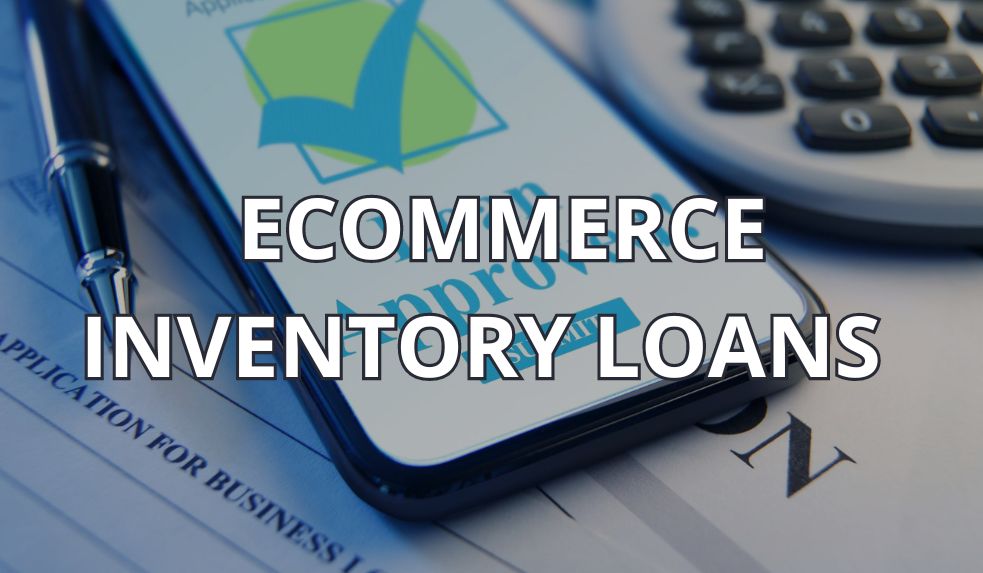Share this
Complete Ecommerce Inventory Financing Guide For 2024
by Kyla Friel on Feb. 23, 2024

Efficient inventory management is a cornerstone of ecommerce success — and this includes managing the costs that come with having inventory. Managing inventory costs can often present a significant challenge, impacting both cash flow and the ability to meet customer demand. Many ecommerce businesses turn to inventory financing as a strategic solution to managing inventory costs and ensuring they have enough stock to successfully fill online orders, all while keeping cash flow free for other business needs.
With ecommerce inventory financing, businesses can balance their operational needs and growth initiatives, ensuring they're well-prepared for fluctuating market demands and busy seasons. However, there are many different routes a business can take when it comes to inventory financing, from more traditional funding like bank loans to more unconventional financing options like revenue-based lending and crowdfunding. In this guide, we explore the different options available to businesses to fund their inventory.
Understanding Ecommerce Inventory Financing
Inventory financing is primarily about ensuring that the business can purchase and manage its inventory effectively to meet customer demands, capitalize on market opportunities, and maintain operational efficiency. All of these are critical aspects of sustaining and growing an ecommerce operation.
Here are the key reasons why ecommerce businesses might seek an inventory financing loan:
- Purchasing Bulk Inventory: To take advantage of volume discounts or to ensure product availability, ecommerce businesses often need to purchase large quantities of inventory in advance. Loans can provide the necessary capital for these bulk purchases.
- Seasonal Stocking: Ecommerce businesses often face fluctuating demand patterns in line with seasonal trends, holidays, or special events. To capitalize on these peak periods, they may need to stock up on specific products or introduce seasonal items, and can use inventory financing to do so.
- Expanding Product Lines: Diversification of product offerings is a strategic move for ecommerce businesses aiming to capture new market segments or satisfy broader customer needs. Expanding product lines involves investing in entirely new types of inventory, which may require significant capital. This can be acquired through inventory financing.
- Buffering Against Supply Chain Disruptions: In the face of supply chain uncertainties or delays, having extra inventory can be crucial. Loans can help maintain higher levels of stock as a buffer.
- Managing Cash Flow: Inventory financing helps in maintaining cash flow. It allows ecommerce businesses to use their working capital for other operational expenses like marketing, staffing, or technology upgrades.
- Expansion: If an ecommerce business is expanding internationally, it might need additional inventory stored in different locations to ensure timely delivery. Financing can support this global expansion strategy.
There are many reasons why an ecommerce business might want to secure outside financing for their inventory. Thankfully, there are lots of options available.
Types of Ecommerce Inventory Financing
How inventory financing works depends on which route your business chooses to take. Here, we outline two categories: traditional loan options, which are attained through banks and credit unions, and alternative financing options, which range from revenue-based lending to crowdfunding.
Traditional Loan Options
SBA Loans
These loans are guaranteed by the U.S. Small Business Administration (SBA) and are suitable for small to medium-sized ecommerce businesses. They offer competitive interest rates and terms up to 25 years, depending on the purpose of the loan.
SBA loans can be used for working capital, which includes purchasing inventory. The application process is comprehensive, often requiring detailed business plans and financial statements. Approval times can vary, typically taking several weeks to months.
Bank Loans
Traditional bank loans offer varied inventory loan terms based on the business’s credit and financial history. Interest rates can be higher than SBA loans, and terms may range from short to long-term. Banks may require collateral for these loans.
The application process can be rigorous, with requirements for extensive financial documentation. Approval timelines can range from a few weeks to several months.
Lines of Credit
These are revolving credit facilities that allow businesses to draw funds up to a specified limit. This makes them ideal for ongoing inventory needs, and interest is paid only on the amount drawn. They often have variable interest rates.
Lines of credit can be secured or unsecured, with secured options usually having lower interest rates. The approval process is typically faster than traditional loans, often within days or weeks.
Choosing between these options depends on multiple factors. This can include the size of the inventory needed, the business’s financial health, and its ability to meet loan requirements. Each option has its advantages and should be considered in the context of the business’s specific needs and goals.
Alternative Funding Options for Ecommerce
Sometimes, a business might not qualify for a traditional loan, or might not want to go that route to finance their inventory. Thankfully, there are other solutions available in the form of alternative inventory funding.
Vendor Financing
This option allows ecommerce businesses to purchase inventory from a supplier and delay payment for a set period, often 30-90 days. It helps manage cash flow by not tying up capital in inventory immediately. The drawback is that it relies on strong relationships with suppliers. Vendor financing may also not be available for all types of inventory.
Revenue-based Lending
Revenue-based lending businesses like Kickfurther, Clearco, and Wayflyer offer innovative financing solutions tailored for ecommerce. They provide funding based on sales and revenue projections, often with more flexible repayment terms linked to sales performance. However, the cost can be higher than traditional loans. Being eligible often depends on sales history and revenue metrics.
Crowdfunding
Platforms like Kickstarter allow businesses to raise funds through customer pre-orders or donations. This method can validate product demand but requires significant marketing efforts and does not guarantee funding success.
Asset-Based Lending
This involves securing loans against company assets like receivables or inventory as collateral. The lender assesses the value of the company's assets to determine the borrowing base.
For inventory, this might involve evaluating the type, condition, and sales potential of the stock. Based on the valuation, the lender offers a loan up to a certain percentage of the asset's value. This percentage varies depending on the asset type and the lender's policies.
The business repays the loan over time, with interest. The terms and rates depend on the risk assessment of the business and the value of the collateral. Asset-based lending is a viable option for ecommerce businesses that have significant physical assets but may not qualify for traditional loans. It's important for businesses to carefully consider the value of their assets and their ability to repay the loan to avoid the risk of losing their collateral.
Merchant Cash Advances (MCAs)
MCAs provide funds based on future sales, especially credit card transactions. They're quick to obtain and don’t require collateral. The major downside is the high cost and the daily repayment model, which can strain cash flow.
MCAs are suitable for businesses with high and consistent credit card sales. However, they should be approached with caution due to their high cost.
Equity Financing
Equity financing involves raising capital by selling shares or stakes in the business to investors. This option is often pursued by businesses looking for significant funding without the immediate burden of repayments that come with traditional loans. While it provides access to large amounts of capital, it also involves relinquishing a portion of ownership and control in the company.
Grant Programs
Grants are non-repayable funds provided by governments, foundations, or corporations to businesses, often for specific projects or purposes. While they don't require repayment, grants can be highly competitive and often have specific criteria to qualify. Some examples include the FedEx Small Business Grant Contest, the Amber Grant for Women, and various Government grants.
Business Credit Cards
Business credit cards can be used as a flexible financing tool for short-term needs, including inventory purchases. They offer the advantage of immediate access to funds and potential rewards. However, businesses must manage this option carefully because of the typically higher interest rates associated with credit card debt. Some examples include the American Express Business Gold card, the Chase Ink Business Preferred card, and the Capital One Spark Cash for Business Card.
Interested in learning more about inventory financing options for ecommerce businesses, including pros, cons, and qualifying criteria? Download our free inventory financing guide below.
Download our Inventory Financing Guide
Qualifying for Ecommerce Inventory Financing
There are certain criteria your business might have to meet to successfully apply for inventory financing. The exact criteria will depend on which option your business chooses, but most lenders or alternative funding options will look at the following areas of your business.
Financial Statements
Lenders critically assess financial statements to gauge the financial health of a business. The balance sheet gives them a snapshot of the company's assets and liabilities, including current inventory levels. The income statement, or profit and loss statement, shows the company's revenue, costs, and expenses over a period.
The cash flow statement is equally vital. It reveals how well the company manages its cash inflows and outflows. This is a crucial indicator of its ability to repay the loan. Consistently strong financial statements can demonstrate a business's stability and growth potential.
Credit History
Credit history plays a significant role in the approval process. For small business owners, personal credit history might be considered. This is especially true for options like SBA loans, which require a personal credit report as part of the application process. More established businesses are usually evaluated based on their business credit history. A high credit score, which indicates a history of timely debt repayment, is often a prerequisite.
Effective Inventory Management Practices
Efficient inventory management is crucial for securing inventory financing. Lenders look for businesses that can effectively manage their inventory levels, as it reduces the risk of stockouts or overstocking, both of which can adversely affect the business's finances. Practices like employing advanced inventory management systems can demonstrate that the business has a handle on its inventory and demand, making it a less risky investment.
Strong Business Plan
For inventory financing, a well-crafted business plan is essential. This plan should detail how the additional inventory will drive business growth and revenue. It should include a comprehensive market analysis, a clear description of the target audience, a thorough understanding of the competitive landscape, and detailed sales forecasts.
The business plan should also articulate strategies for inventory turnover. This illustrates how the business intends to convert the financed inventory into sales effectively.
Making the Right Ecommerce Inventory Financing Choice
Your inventory financing choice should align with your business’s operational needs, growth plans, and financial health. Small businesses might prefer options with fewer collateral requirements and more flexibility, while larger businesses may opt for solutions that can support more substantial inventory investments. Understanding the trade-offs between different financing options and how they align with your business model is crucial.
Having sufficient inventory is key to running a successful ecommerce business. However, managing the amount of inventory you need, along with fulfilling all of your online orders, can take up a lot of time and resources. Partnering with a Third-Party Logistics (3PL) company like Shipfusion can take the stress of inventory management and order fulfillment off your plate, so you can focus on scaling your business. If you’re interested in achieving stress-free, accurate order fulfillment, learn more about our inventory management software.
Share this
You May Also Like
These Related Articles

Guide to Alternative Inventory Funding Options for Ecommerce

Guide to Inventory Loans for Ecommerce

The 8 Best Buy Now Pay Later Companies In Ecommerce Today
- April 2025 (9)
- March 2025 (26)
- February 2025 (26)
- January 2025 (37)
- December 2024 (16)
- November 2024 (23)
- October 2024 (22)
- September 2024 (27)
- August 2024 (9)
- July 2024 (8)
- June 2024 (5)
- May 2024 (8)
- April 2024 (8)
- March 2024 (6)
- February 2024 (6)
- January 2024 (5)
- December 2023 (3)
- November 2023 (3)
- October 2023 (5)
- September 2023 (4)
- August 2023 (2)
- July 2023 (1)
- June 2023 (4)
- March 2023 (2)
- October 2022 (1)
- September 2022 (5)
- August 2022 (4)
- July 2022 (7)
- June 2022 (4)
- May 2022 (4)
- April 2022 (6)
- March 2022 (2)
- February 2022 (1)
- January 2022 (3)
- December 2021 (2)
- November 2021 (4)
- October 2021 (2)
- September 2021 (5)
- August 2021 (4)
- July 2021 (4)
- June 2021 (3)
- May 2021 (2)
- April 2021 (3)
- March 2021 (3)
- February 2021 (3)
- January 2021 (2)
- December 2020 (4)
- November 2020 (2)
- October 2020 (4)
- September 2020 (2)
- July 2020 (5)
- June 2020 (4)
- May 2020 (2)
- April 2020 (2)
- March 2020 (4)
- February 2020 (1)
- December 2019 (1)
- May 2018 (1)
- March 2018 (2)
- February 2018 (3)
- January 2018 (3)
- November 2017 (3)
- July 2017 (4)
- March 2017 (3)
- February 2017 (5)
- January 2017 (3)
- December 2016 (4)
- November 2016 (6)
- October 2016 (6)
- October 2015 (1)
- September 2015 (1)
- June 2015 (3)
- May 2015 (3)
- August 2014 (1)
- July 2014 (1)
- March 2014 (1)
- February 2014 (1)